The Ethics of Intrusive Animal Testing in Scientific Research
VerifiedAdded on 2021/05/30
|13
|1764
|174
Essay
AI Summary
This essay critically examines the ethical implications of intrusive animal testing in scientific research, arguing for its discontinuation due to advancements in technology and ethical concerns. The essay highlights the historical reasons for animal testing, primarily human safety and limited alternatives, while acknowledging the vulnerability of animals. It presents varying viewpoints from doctors and scientists, including the 3R principle (Replacement, Refinement, Reduction) as a more ethical approach. The study also discusses alternative testing methods like stem cell technology and tissue cultures. It emphasizes the need to balance scientific advancement with ethical treatment of animals, advocating for the adoption of animal-free testing methods and stricter regulations to eliminate unnecessary animal cruelty. The essay concludes that continuing animal testing, despite available alternatives, disrupts nature's equilibrium and calls for global efforts to prioritize advanced, ethical research practices.
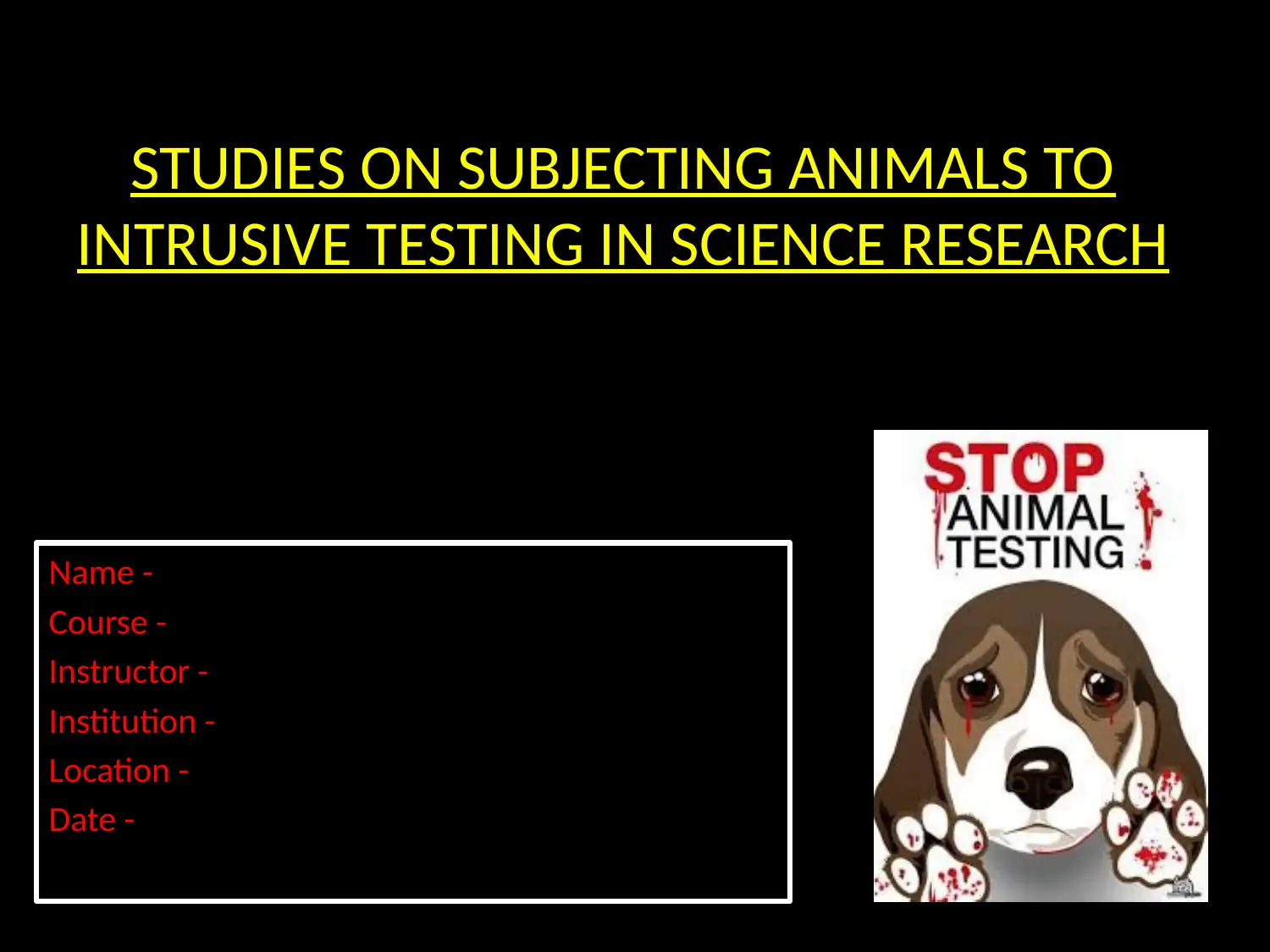
STUDIES ON SUBJECTING ANIMALS TO
INTRUSIVE TESTING IN SCIENCE RESEARCH
Name -
Course -
Instructor -
Institution -
Location -
Date -
INTRUSIVE TESTING IN SCIENCE RESEARCH
Name -
Course -
Instructor -
Institution -
Location -
Date -
Paraphrase This Document
Need a fresh take? Get an instant paraphrase of this document with our AI Paraphraser
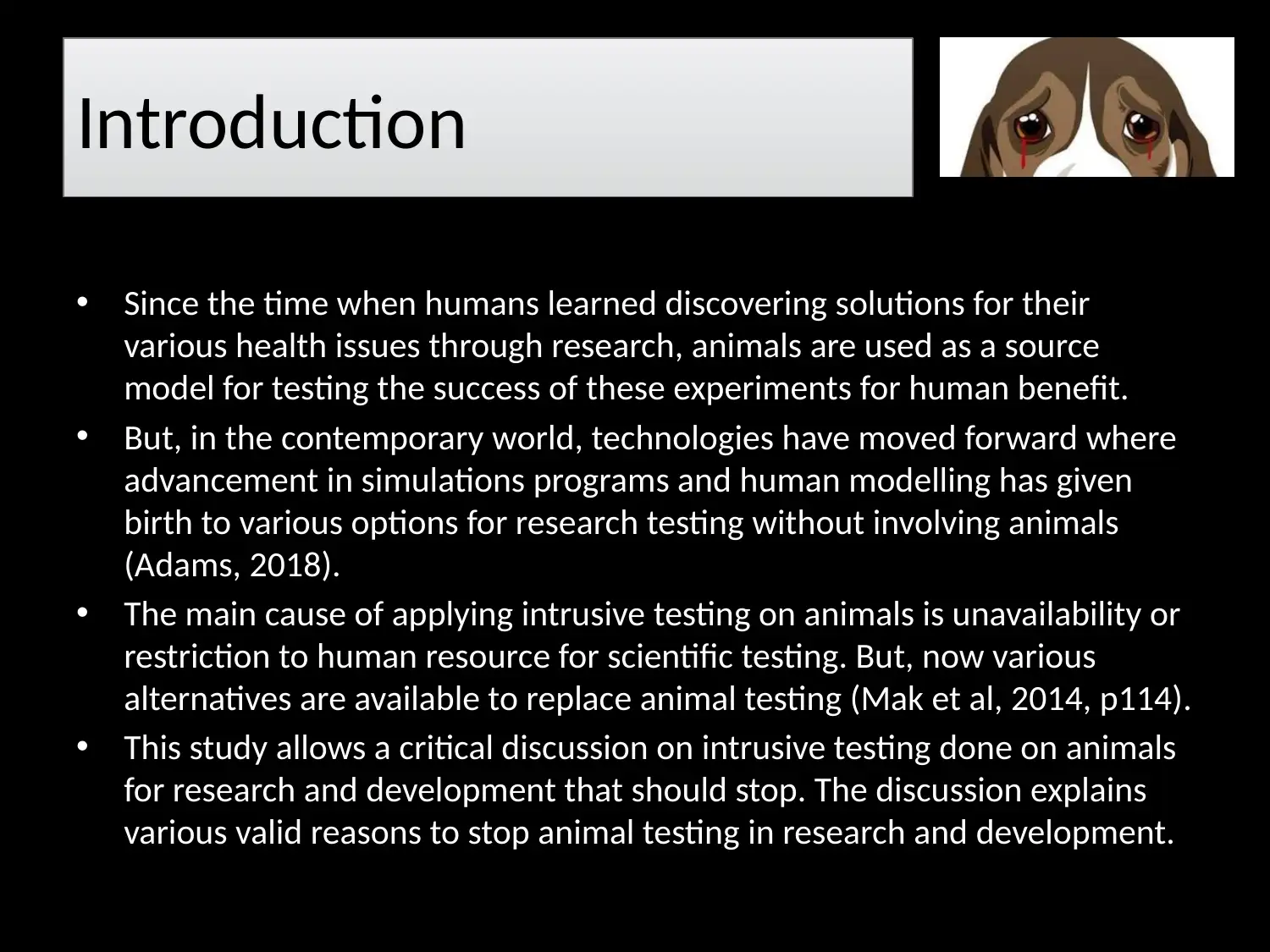
Introduction
• Since the time when humans learned discovering solutions for their
various health issues through research, animals are used as a source
model for testing the success of these experiments for human benefit.
• But, in the contemporary world, technologies have moved forward where
advancement in simulations programs and human modelling has given
birth to various options for research testing without involving animals
(Adams, 2018).
• The main cause of applying intrusive testing on animals is unavailability or
restriction to human resource for scientific testing. But, now various
alternatives are available to replace animal testing (Mak et al, 2014, p114).
• This study allows a critical discussion on intrusive testing done on animals
for research and development that should stop. The discussion explains
various valid reasons to stop animal testing in research and development.
• Since the time when humans learned discovering solutions for their
various health issues through research, animals are used as a source
model for testing the success of these experiments for human benefit.
• But, in the contemporary world, technologies have moved forward where
advancement in simulations programs and human modelling has given
birth to various options for research testing without involving animals
(Adams, 2018).
• The main cause of applying intrusive testing on animals is unavailability or
restriction to human resource for scientific testing. But, now various
alternatives are available to replace animal testing (Mak et al, 2014, p114).
• This study allows a critical discussion on intrusive testing done on animals
for research and development that should stop. The discussion explains
various valid reasons to stop animal testing in research and development.
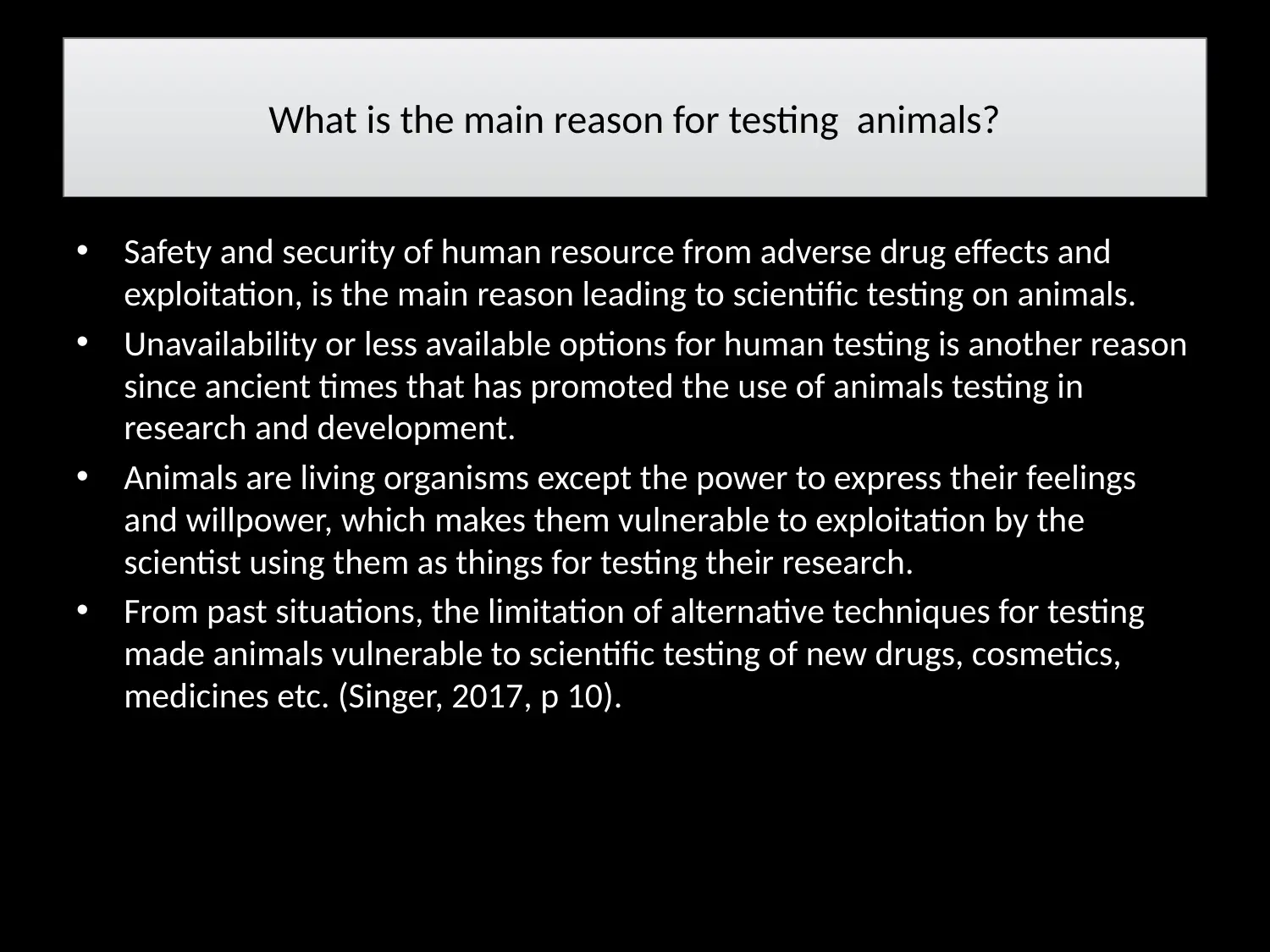
What is the main reason for testing animals?
• Safety and security of human resource from adverse drug effects and
exploitation, is the main reason leading to scientific testing on animals.
• Unavailability or less available options for human testing is another reason
since ancient times that has promoted the use of animals testing in
research and development.
• Animals are living organisms except the power to express their feelings
and willpower, which makes them vulnerable to exploitation by the
scientist using them as things for testing their research.
• From past situations, the limitation of alternative techniques for testing
made animals vulnerable to scientific testing of new drugs, cosmetics,
medicines etc. (Singer, 2017, p 10).
• Safety and security of human resource from adverse drug effects and
exploitation, is the main reason leading to scientific testing on animals.
• Unavailability or less available options for human testing is another reason
since ancient times that has promoted the use of animals testing in
research and development.
• Animals are living organisms except the power to express their feelings
and willpower, which makes them vulnerable to exploitation by the
scientist using them as things for testing their research.
• From past situations, the limitation of alternative techniques for testing
made animals vulnerable to scientific testing of new drugs, cosmetics,
medicines etc. (Singer, 2017, p 10).
⊘ This is a preview!⊘
Do you want full access?
Subscribe today to unlock all pages.

Trusted by 1+ million students worldwide
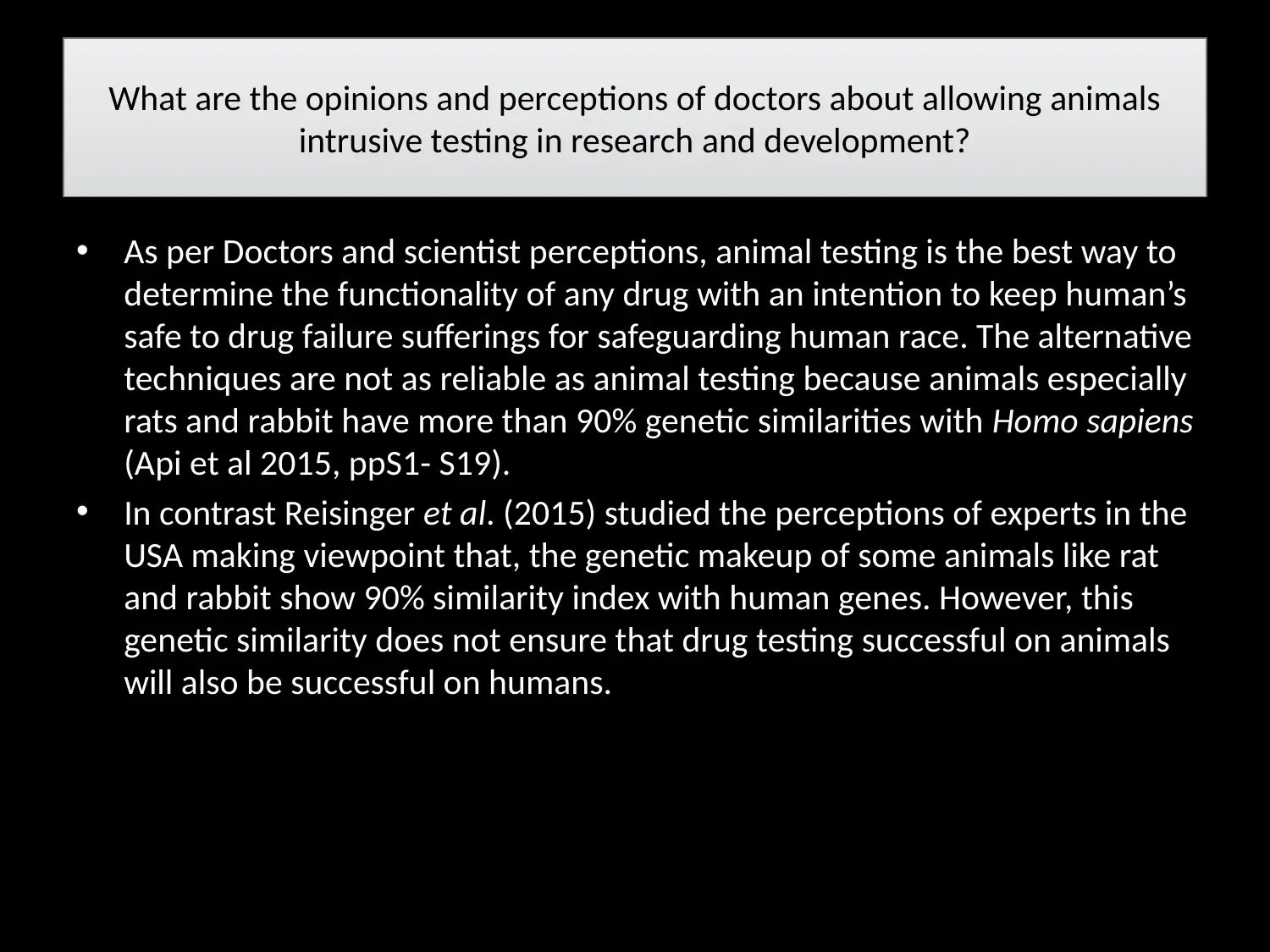
What are the opinions and perceptions of doctors about allowing animals
intrusive testing in research and development?
• As per Doctors and scientist perceptions, animal testing is the best way to
determine the functionality of any drug with an intention to keep human’s
safe to drug failure sufferings for safeguarding human race. The alternative
techniques are not as reliable as animal testing because animals especially
rats and rabbit have more than 90% genetic similarities with Homo sapiens
(Api et al 2015, ppS1- S19).
• In contrast Reisinger et al. (2015) studied the perceptions of experts in the
USA making viewpoint that, the genetic makeup of some animals like rat
and rabbit show 90% similarity index with human genes. However, this
genetic similarity does not ensure that drug testing successful on animals
will also be successful on humans.
intrusive testing in research and development?
• As per Doctors and scientist perceptions, animal testing is the best way to
determine the functionality of any drug with an intention to keep human’s
safe to drug failure sufferings for safeguarding human race. The alternative
techniques are not as reliable as animal testing because animals especially
rats and rabbit have more than 90% genetic similarities with Homo sapiens
(Api et al 2015, ppS1- S19).
• In contrast Reisinger et al. (2015) studied the perceptions of experts in the
USA making viewpoint that, the genetic makeup of some animals like rat
and rabbit show 90% similarity index with human genes. However, this
genetic similarity does not ensure that drug testing successful on animals
will also be successful on humans.
Paraphrase This Document
Need a fresh take? Get an instant paraphrase of this document with our AI Paraphraser
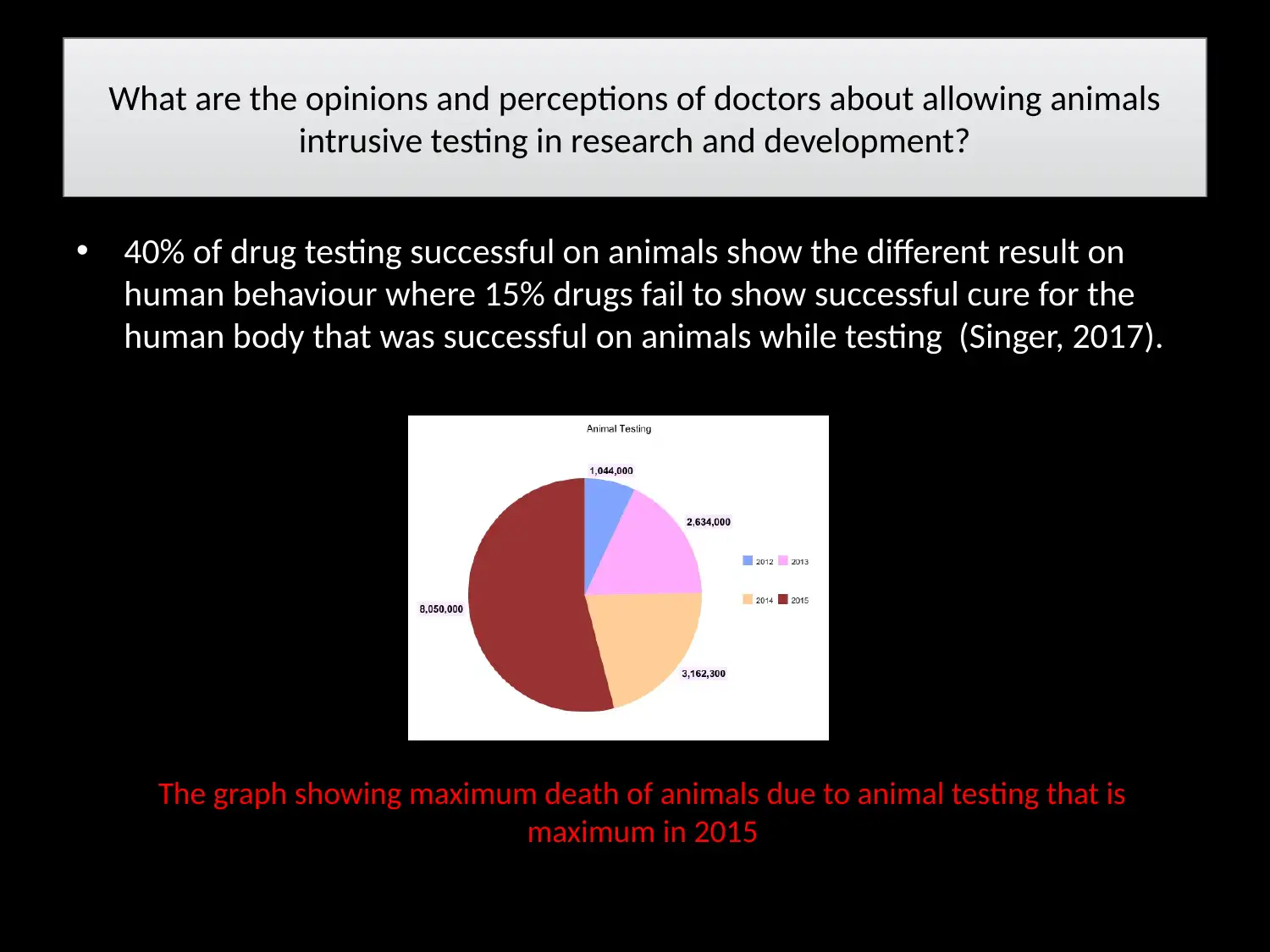
What are the opinions and perceptions of doctors about allowing animals
intrusive testing in research and development?
• 40% of drug testing successful on animals show the different result on
human behaviour where 15% drugs fail to show successful cure for the
human body that was successful on animals while testing (Singer, 2017).
The graph showing maximum death of animals due to animal testing that is
maximum in 2015
intrusive testing in research and development?
• 40% of drug testing successful on animals show the different result on
human behaviour where 15% drugs fail to show successful cure for the
human body that was successful on animals while testing (Singer, 2017).
The graph showing maximum death of animals due to animal testing that is
maximum in 2015
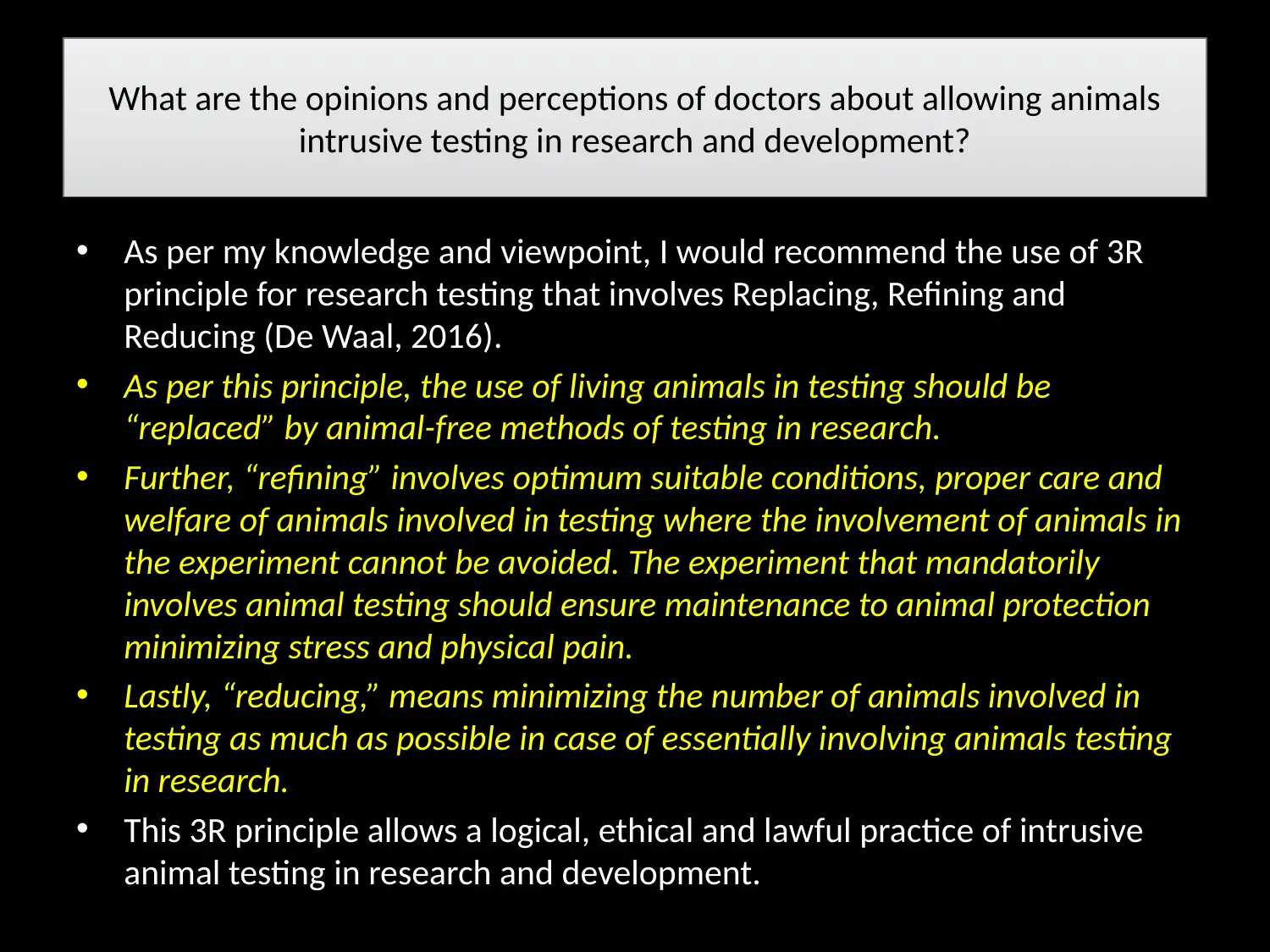
What are the opinions and perceptions of doctors about allowing animals
intrusive testing in research and development?
• As per my knowledge and viewpoint, I would recommend the use of 3R
principle for research testing that involves Replacing, Refining and
Reducing (De Waal, 2016).
• As per this principle, the use of living animals in testing should be
“replaced” by animal-free methods of testing in research.
• Further, “refining” involves optimum suitable conditions, proper care and
welfare of animals involved in testing where the involvement of animals in
the experiment cannot be avoided. The experiment that mandatorily
involves animal testing should ensure maintenance to animal protection
minimizing stress and physical pain.
• Lastly, “reducing,” means minimizing the number of animals involved in
testing as much as possible in case of essentially involving animals testing
in research.
• This 3R principle allows a logical, ethical and lawful practice of intrusive
animal testing in research and development.
intrusive testing in research and development?
• As per my knowledge and viewpoint, I would recommend the use of 3R
principle for research testing that involves Replacing, Refining and
Reducing (De Waal, 2016).
• As per this principle, the use of living animals in testing should be
“replaced” by animal-free methods of testing in research.
• Further, “refining” involves optimum suitable conditions, proper care and
welfare of animals involved in testing where the involvement of animals in
the experiment cannot be avoided. The experiment that mandatorily
involves animal testing should ensure maintenance to animal protection
minimizing stress and physical pain.
• Lastly, “reducing,” means minimizing the number of animals involved in
testing as much as possible in case of essentially involving animals testing
in research.
• This 3R principle allows a logical, ethical and lawful practice of intrusive
animal testing in research and development.
⊘ This is a preview!⊘
Do you want full access?
Subscribe today to unlock all pages.

Trusted by 1+ million students worldwide
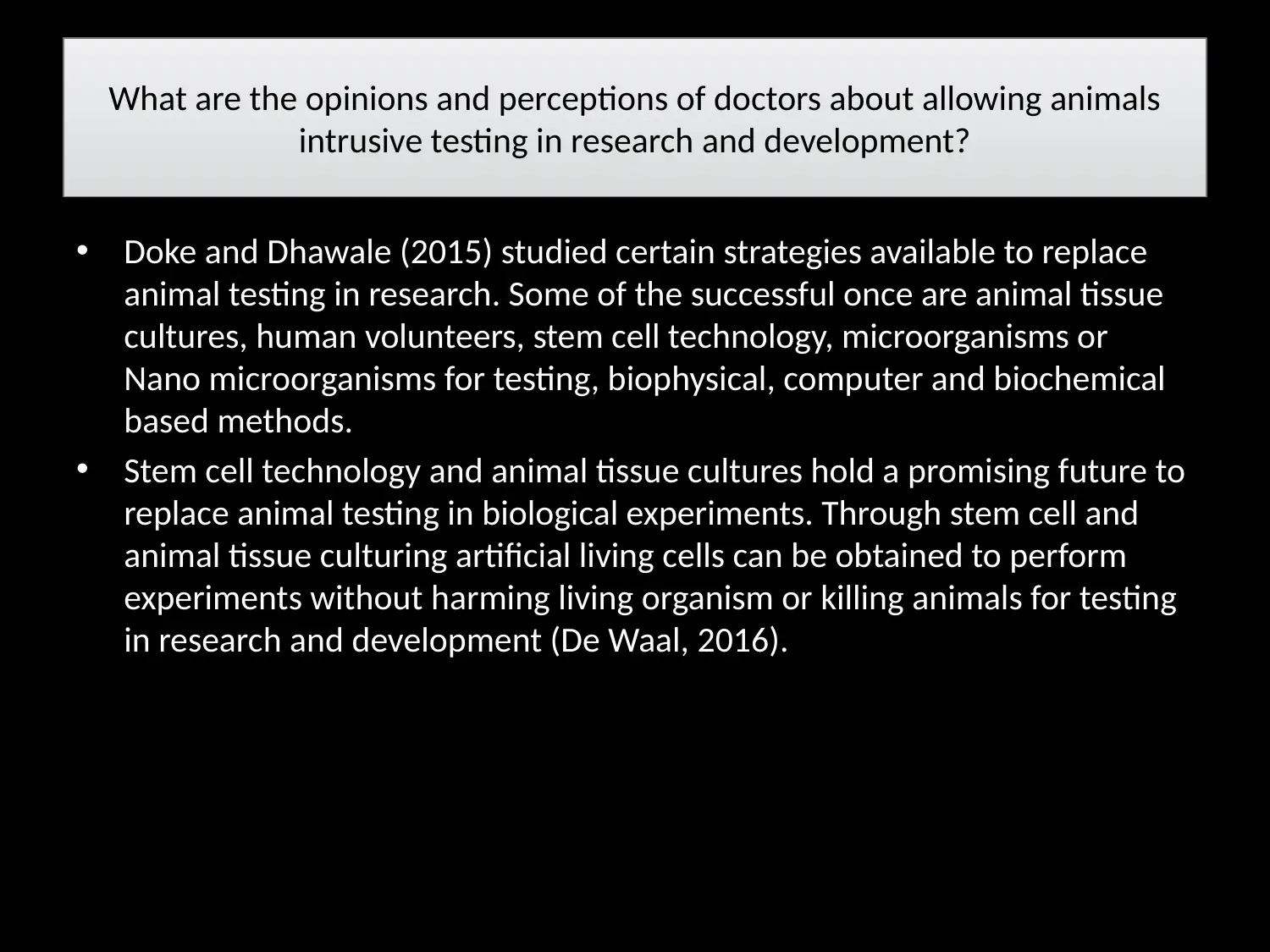
What are the opinions and perceptions of doctors about allowing animals
intrusive testing in research and development?
• Doke and Dhawale (2015) studied certain strategies available to replace
animal testing in research. Some of the successful once are animal tissue
cultures, human volunteers, stem cell technology, microorganisms or
Nano microorganisms for testing, biophysical, computer and biochemical
based methods.
• Stem cell technology and animal tissue cultures hold a promising future to
replace animal testing in biological experiments. Through stem cell and
animal tissue culturing artificial living cells can be obtained to perform
experiments without harming living organism or killing animals for testing
in research and development (De Waal, 2016).
intrusive testing in research and development?
• Doke and Dhawale (2015) studied certain strategies available to replace
animal testing in research. Some of the successful once are animal tissue
cultures, human volunteers, stem cell technology, microorganisms or
Nano microorganisms for testing, biophysical, computer and biochemical
based methods.
• Stem cell technology and animal tissue cultures hold a promising future to
replace animal testing in biological experiments. Through stem cell and
animal tissue culturing artificial living cells can be obtained to perform
experiments without harming living organism or killing animals for testing
in research and development (De Waal, 2016).
Paraphrase This Document
Need a fresh take? Get an instant paraphrase of this document with our AI Paraphraser
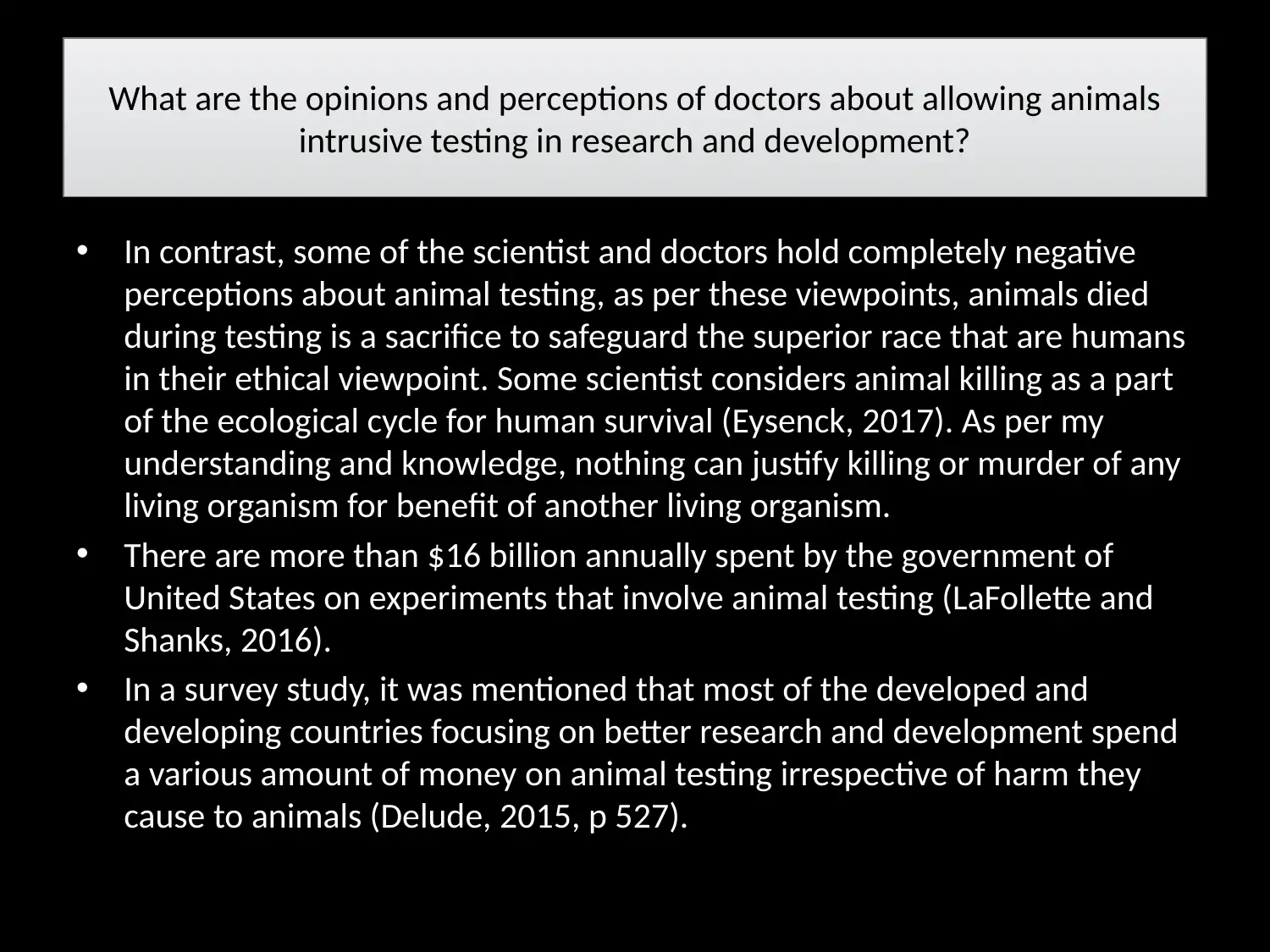
What are the opinions and perceptions of doctors about allowing animals
intrusive testing in research and development?
• In contrast, some of the scientist and doctors hold completely negative
perceptions about animal testing, as per these viewpoints, animals died
during testing is a sacrifice to safeguard the superior race that are humans
in their ethical viewpoint. Some scientist considers animal killing as a part
of the ecological cycle for human survival (Eysenck, 2017). As per my
understanding and knowledge, nothing can justify killing or murder of any
living organism for benefit of another living organism.
• There are more than $16 billion annually spent by the government of
United States on experiments that involve animal testing (LaFollette and
Shanks, 2016).
• In a survey study, it was mentioned that most of the developed and
developing countries focusing on better research and development spend
a various amount of money on animal testing irrespective of harm they
cause to animals (Delude, 2015, p 527).
intrusive testing in research and development?
• In contrast, some of the scientist and doctors hold completely negative
perceptions about animal testing, as per these viewpoints, animals died
during testing is a sacrifice to safeguard the superior race that are humans
in their ethical viewpoint. Some scientist considers animal killing as a part
of the ecological cycle for human survival (Eysenck, 2017). As per my
understanding and knowledge, nothing can justify killing or murder of any
living organism for benefit of another living organism.
• There are more than $16 billion annually spent by the government of
United States on experiments that involve animal testing (LaFollette and
Shanks, 2016).
• In a survey study, it was mentioned that most of the developed and
developing countries focusing on better research and development spend
a various amount of money on animal testing irrespective of harm they
cause to animals (Delude, 2015, p 527).
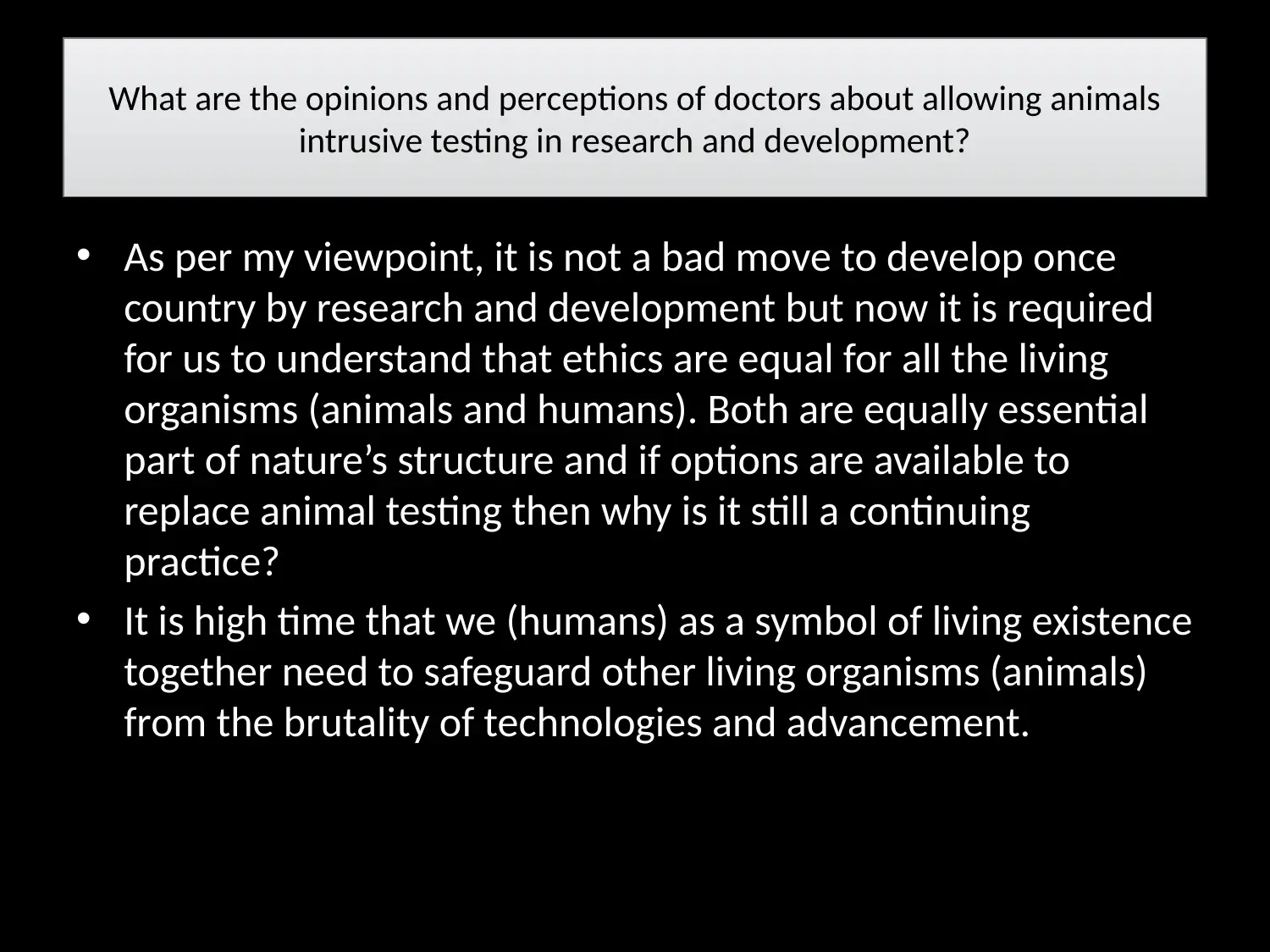
What are the opinions and perceptions of doctors about allowing animals
intrusive testing in research and development?
• As per my viewpoint, it is not a bad move to develop once
country by research and development but now it is required
for us to understand that ethics are equal for all the living
organisms (animals and humans). Both are equally essential
part of nature’s structure and if options are available to
replace animal testing then why is it still a continuing
practice?
• It is high time that we (humans) as a symbol of living existence
together need to safeguard other living organisms (animals)
from the brutality of technologies and advancement.
intrusive testing in research and development?
• As per my viewpoint, it is not a bad move to develop once
country by research and development but now it is required
for us to understand that ethics are equal for all the living
organisms (animals and humans). Both are equally essential
part of nature’s structure and if options are available to
replace animal testing then why is it still a continuing
practice?
• It is high time that we (humans) as a symbol of living existence
together need to safeguard other living organisms (animals)
from the brutality of technologies and advancement.
⊘ This is a preview!⊘
Do you want full access?
Subscribe today to unlock all pages.

Trusted by 1+ million students worldwide
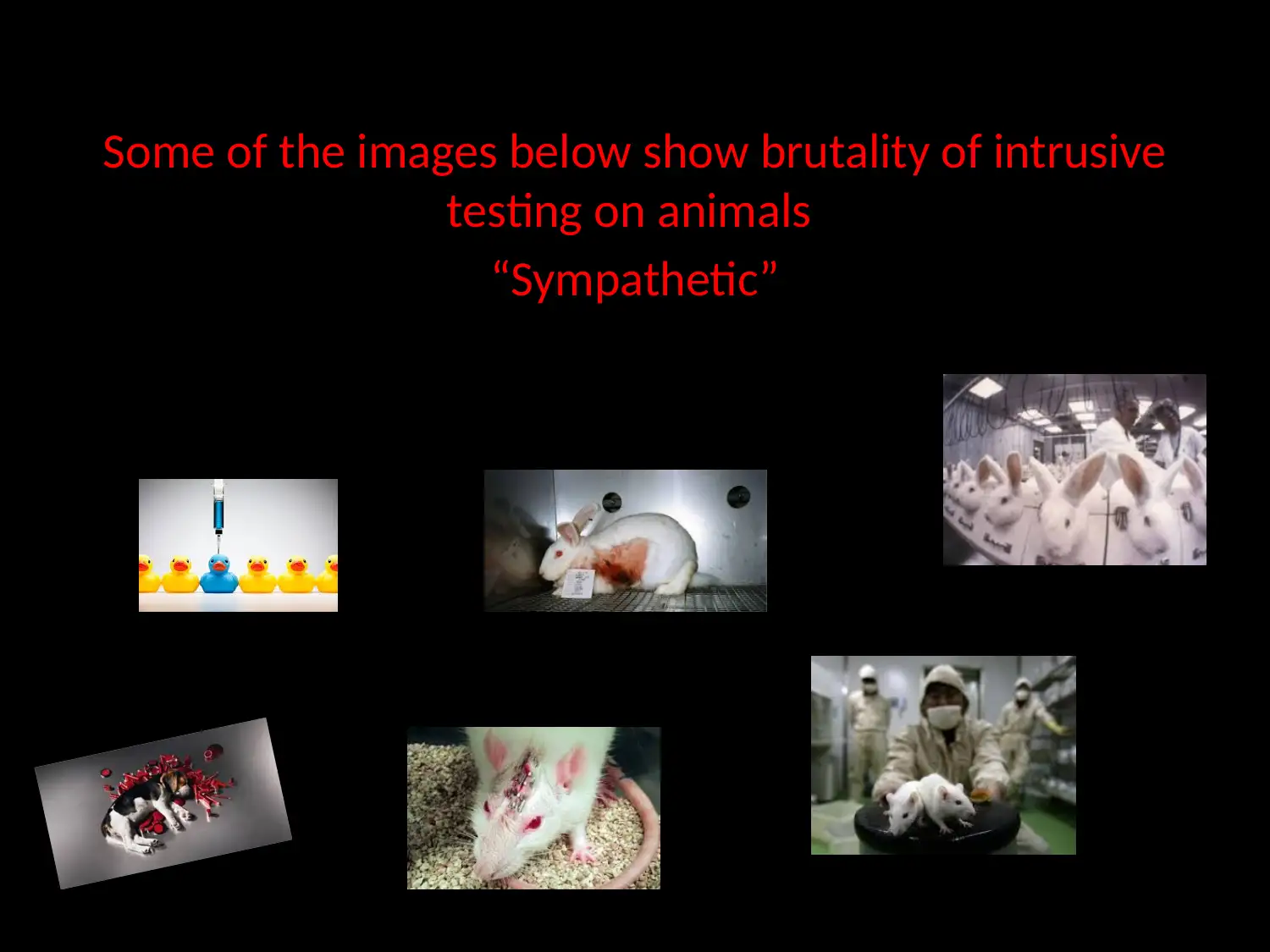
Some of the images below show brutality of intrusive
testing on animals
“Sympathetic”
testing on animals
“Sympathetic”
Paraphrase This Document
Need a fresh take? Get an instant paraphrase of this document with our AI Paraphraser
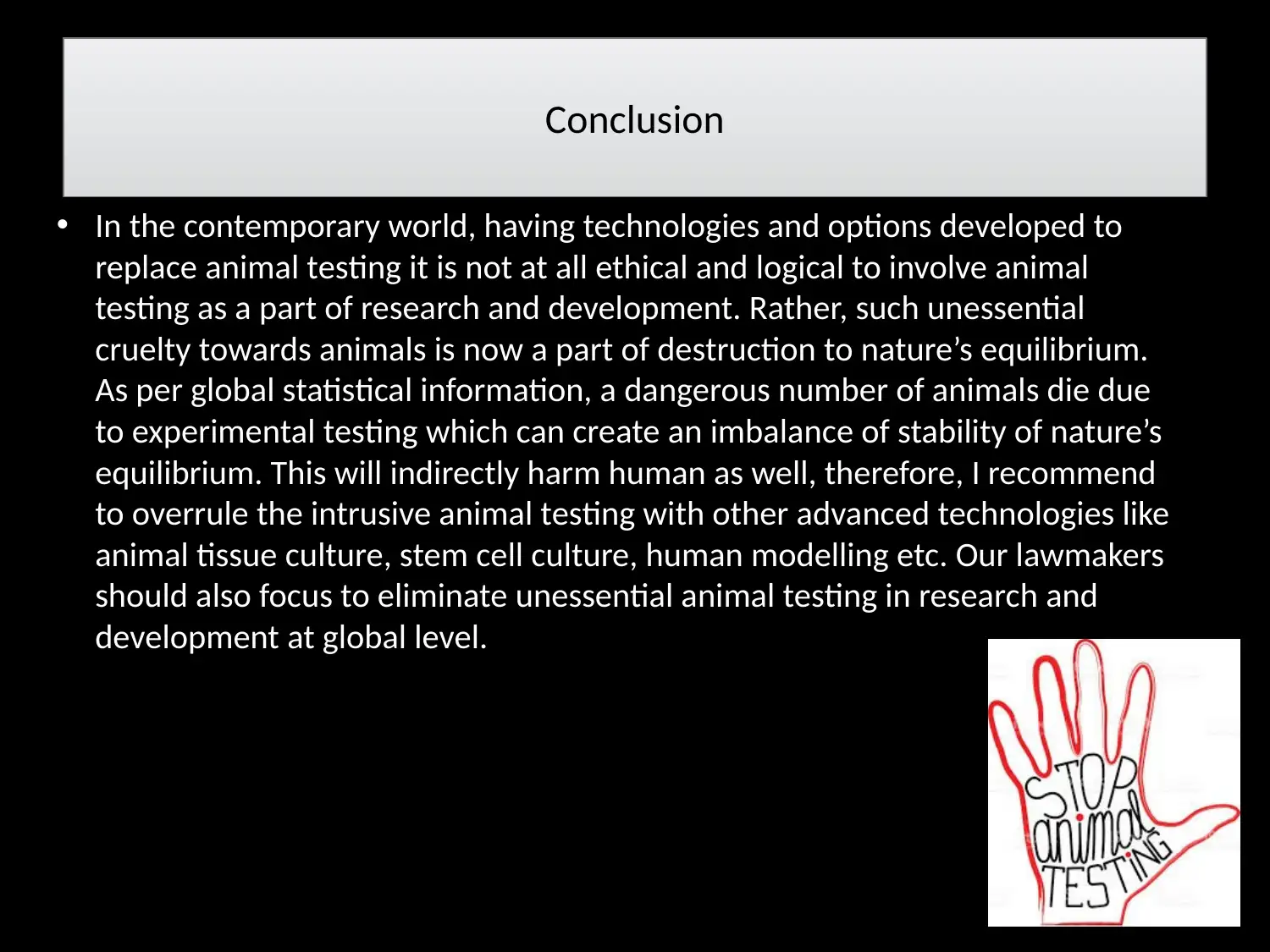
Conclusion
• In the contemporary world, having technologies and options developed to
replace animal testing it is not at all ethical and logical to involve animal
testing as a part of research and development. Rather, such unessential
cruelty towards animals is now a part of destruction to nature’s equilibrium.
As per global statistical information, a dangerous number of animals die due
to experimental testing which can create an imbalance of stability of nature’s
equilibrium. This will indirectly harm human as well, therefore, I recommend
to overrule the intrusive animal testing with other advanced technologies like
animal tissue culture, stem cell culture, human modelling etc. Our lawmakers
should also focus to eliminate unessential animal testing in research and
development at global level.
• In the contemporary world, having technologies and options developed to
replace animal testing it is not at all ethical and logical to involve animal
testing as a part of research and development. Rather, such unessential
cruelty towards animals is now a part of destruction to nature’s equilibrium.
As per global statistical information, a dangerous number of animals die due
to experimental testing which can create an imbalance of stability of nature’s
equilibrium. This will indirectly harm human as well, therefore, I recommend
to overrule the intrusive animal testing with other advanced technologies like
animal tissue culture, stem cell culture, human modelling etc. Our lawmakers
should also focus to eliminate unessential animal testing in research and
development at global level.
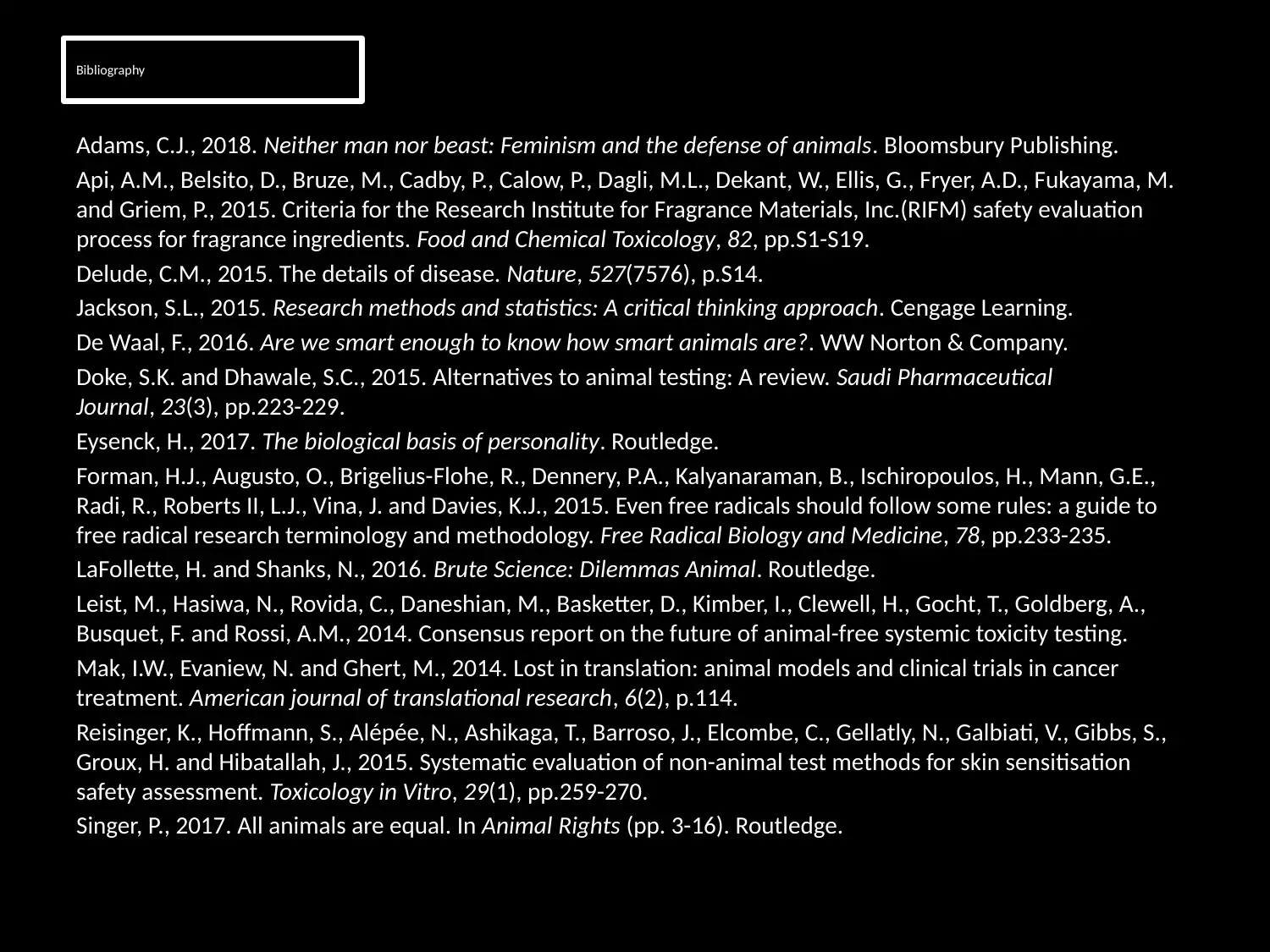
Bibliography
Adams, C.J., 2018. Neither man nor beast: Feminism and the defense of animals. Bloomsbury Publishing.
Api, A.M., Belsito, D., Bruze, M., Cadby, P., Calow, P., Dagli, M.L., Dekant, W., Ellis, G., Fryer, A.D., Fukayama, M.
and Griem, P., 2015. Criteria for the Research Institute for Fragrance Materials, Inc.(RIFM) safety evaluation
process for fragrance ingredients. Food and Chemical Toxicology, 82, pp.S1-S19.
Delude, C.M., 2015. The details of disease. Nature, 527(7576), p.S14.
Jackson, S.L., 2015. Research methods and statistics: A critical thinking approach. Cengage Learning.
De Waal, F., 2016. Are we smart enough to know how smart animals are?. WW Norton & Company.
Doke, S.K. and Dhawale, S.C., 2015. Alternatives to animal testing: A review. Saudi Pharmaceutical
Journal, 23(3), pp.223-229.
Eysenck, H., 2017. The biological basis of personality. Routledge.
Forman, H.J., Augusto, O., Brigelius-Flohe, R., Dennery, P.A., Kalyanaraman, B., Ischiropoulos, H., Mann, G.E.,
Radi, R., Roberts II, L.J., Vina, J. and Davies, K.J., 2015. Even free radicals should follow some rules: a guide to
free radical research terminology and methodology. Free Radical Biology and Medicine, 78, pp.233-235.
LaFollette, H. and Shanks, N., 2016. Brute Science: Dilemmas Animal. Routledge.
Leist, M., Hasiwa, N., Rovida, C., Daneshian, M., Basketter, D., Kimber, I., Clewell, H., Gocht, T., Goldberg, A.,
Busquet, F. and Rossi, A.M., 2014. Consensus report on the future of animal-free systemic toxicity testing.
Mak, I.W., Evaniew, N. and Ghert, M., 2014. Lost in translation: animal models and clinical trials in cancer
treatment. American journal of translational research, 6(2), p.114.
Reisinger, K., Hoffmann, S., Alépée, N., Ashikaga, T., Barroso, J., Elcombe, C., Gellatly, N., Galbiati, V., Gibbs, S.,
Groux, H. and Hibatallah, J., 2015. Systematic evaluation of non-animal test methods for skin sensitisation
safety assessment. Toxicology in Vitro, 29(1), pp.259-270.
Singer, P., 2017. All animals are equal. In Animal Rights (pp. 3-16). Routledge.
Adams, C.J., 2018. Neither man nor beast: Feminism and the defense of animals. Bloomsbury Publishing.
Api, A.M., Belsito, D., Bruze, M., Cadby, P., Calow, P., Dagli, M.L., Dekant, W., Ellis, G., Fryer, A.D., Fukayama, M.
and Griem, P., 2015. Criteria for the Research Institute for Fragrance Materials, Inc.(RIFM) safety evaluation
process for fragrance ingredients. Food and Chemical Toxicology, 82, pp.S1-S19.
Delude, C.M., 2015. The details of disease. Nature, 527(7576), p.S14.
Jackson, S.L., 2015. Research methods and statistics: A critical thinking approach. Cengage Learning.
De Waal, F., 2016. Are we smart enough to know how smart animals are?. WW Norton & Company.
Doke, S.K. and Dhawale, S.C., 2015. Alternatives to animal testing: A review. Saudi Pharmaceutical
Journal, 23(3), pp.223-229.
Eysenck, H., 2017. The biological basis of personality. Routledge.
Forman, H.J., Augusto, O., Brigelius-Flohe, R., Dennery, P.A., Kalyanaraman, B., Ischiropoulos, H., Mann, G.E.,
Radi, R., Roberts II, L.J., Vina, J. and Davies, K.J., 2015. Even free radicals should follow some rules: a guide to
free radical research terminology and methodology. Free Radical Biology and Medicine, 78, pp.233-235.
LaFollette, H. and Shanks, N., 2016. Brute Science: Dilemmas Animal. Routledge.
Leist, M., Hasiwa, N., Rovida, C., Daneshian, M., Basketter, D., Kimber, I., Clewell, H., Gocht, T., Goldberg, A.,
Busquet, F. and Rossi, A.M., 2014. Consensus report on the future of animal-free systemic toxicity testing.
Mak, I.W., Evaniew, N. and Ghert, M., 2014. Lost in translation: animal models and clinical trials in cancer
treatment. American journal of translational research, 6(2), p.114.
Reisinger, K., Hoffmann, S., Alépée, N., Ashikaga, T., Barroso, J., Elcombe, C., Gellatly, N., Galbiati, V., Gibbs, S.,
Groux, H. and Hibatallah, J., 2015. Systematic evaluation of non-animal test methods for skin sensitisation
safety assessment. Toxicology in Vitro, 29(1), pp.259-270.
Singer, P., 2017. All animals are equal. In Animal Rights (pp. 3-16). Routledge.
⊘ This is a preview!⊘
Do you want full access?
Subscribe today to unlock all pages.

Trusted by 1+ million students worldwide
1 out of 13
Your All-in-One AI-Powered Toolkit for Academic Success.
+13062052269
info@desklib.com
Available 24*7 on WhatsApp / Email
![[object Object]](/_next/static/media/star-bottom.7253800d.svg)
Unlock your academic potential
Copyright © 2020–2025 A2Z Services. All Rights Reserved. Developed and managed by ZUCOL.

